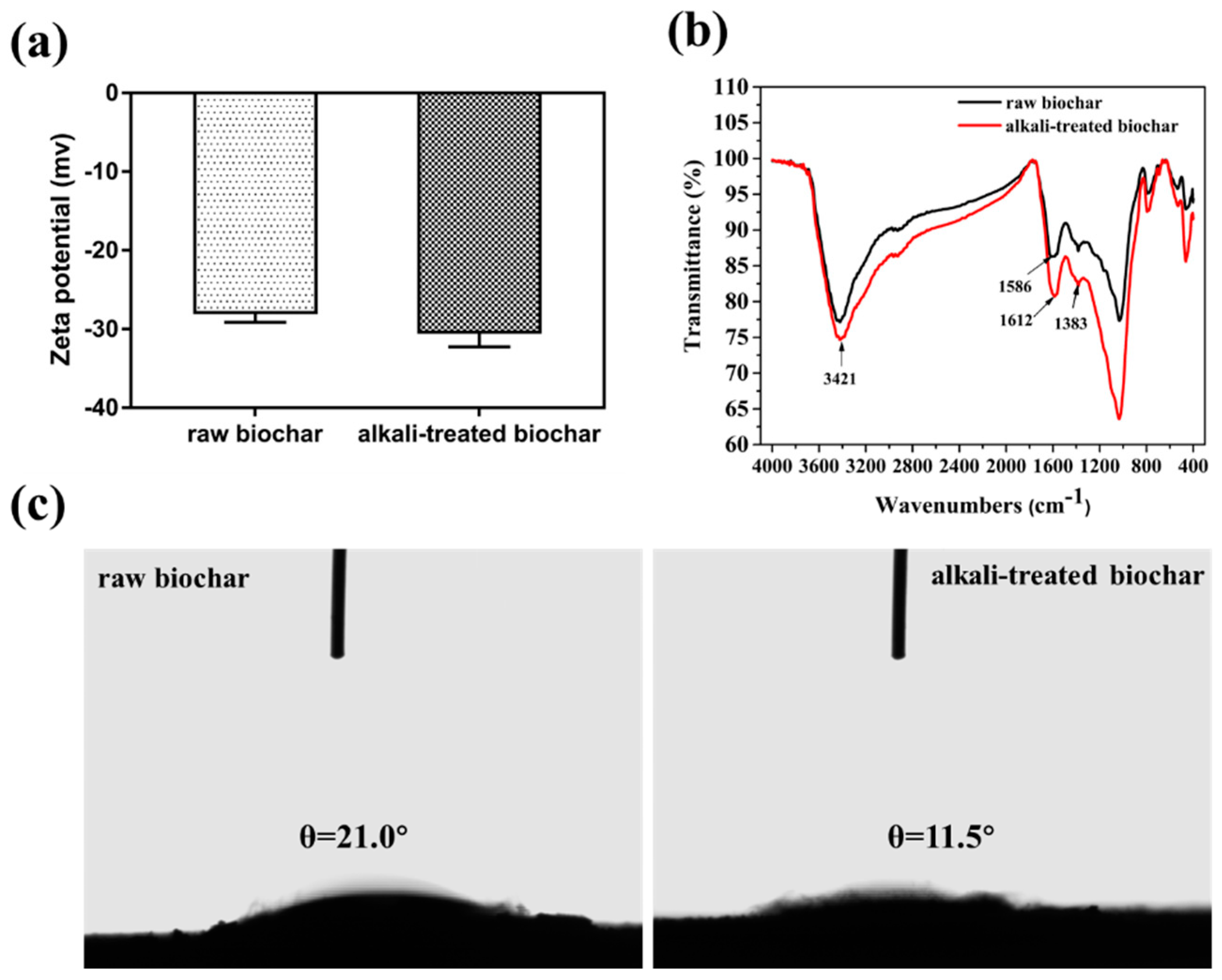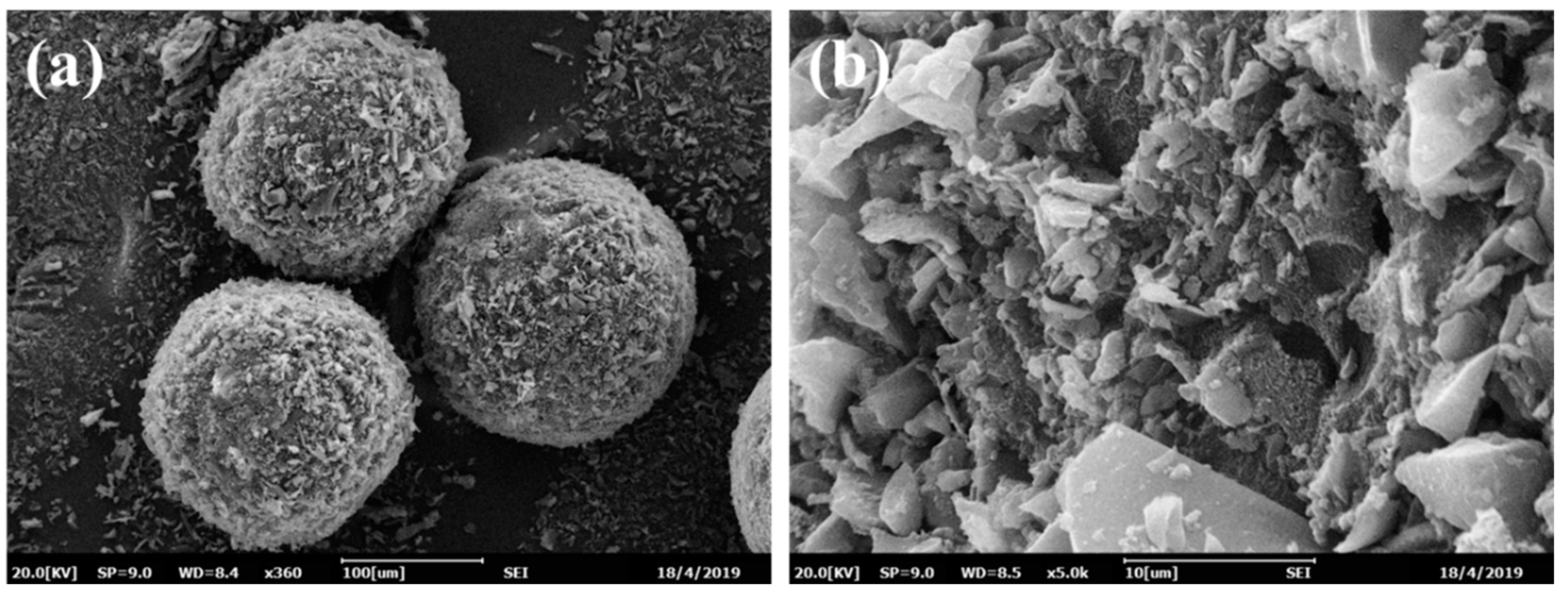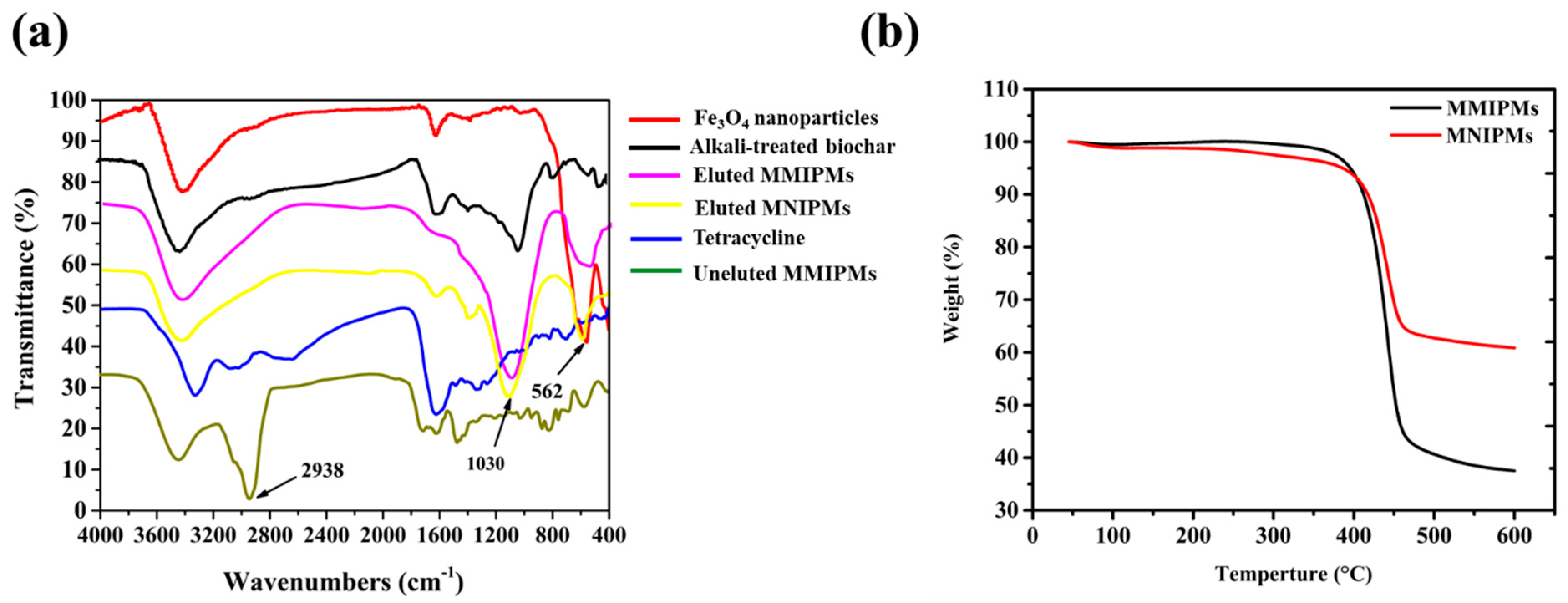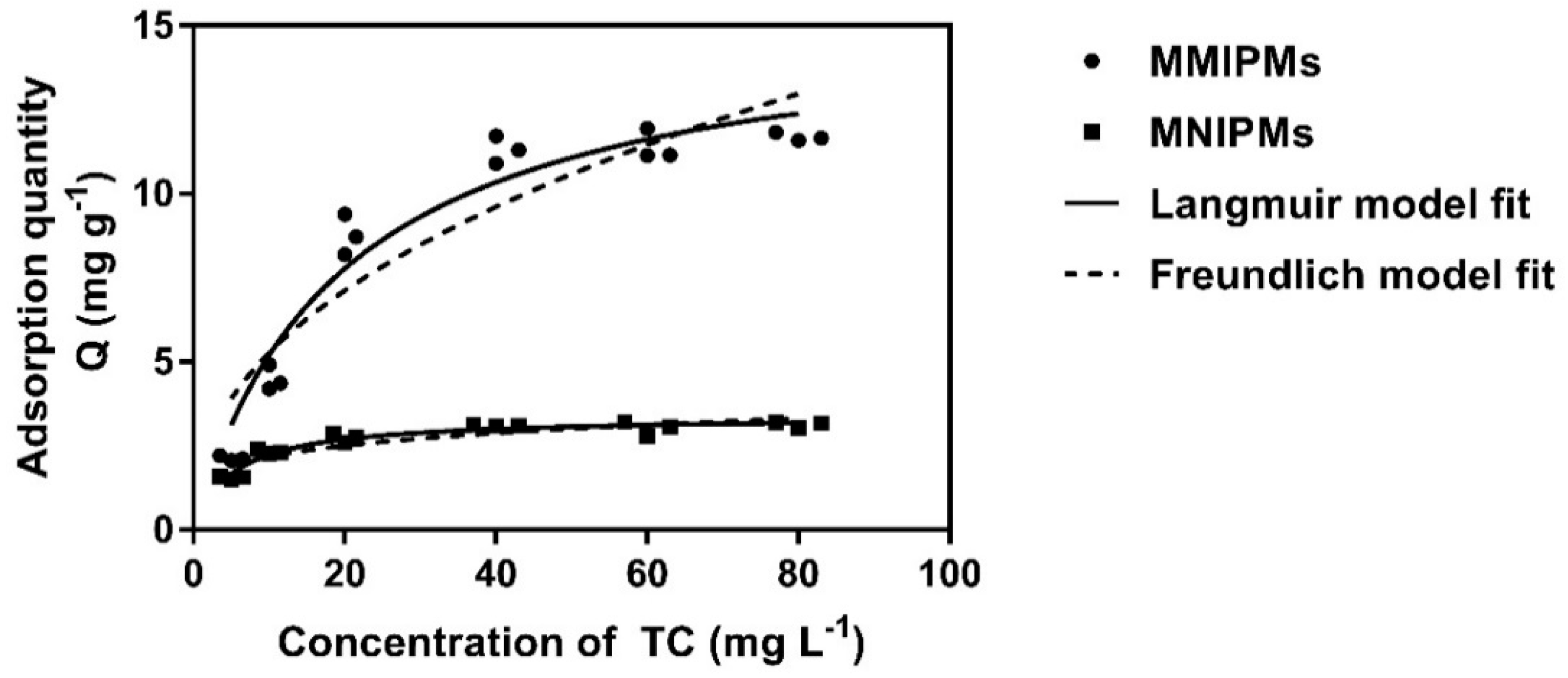A Mild Method for Preparation of Highly Selective Magnetic Biochar Microspheres
Abstract
:1. Introduction
2. Results and Discussion
2.1. Surface Properties of Raw and Alkali-Treated Biochar
2.2. Characterization of MMIPMs
2.2.1. SEM Characterization of MMIPMs
2.2.2. Brunner-Emmet-Teller (BET) Measurements
2.2.3. Magnetic Characterization of MMIPMs
2.2.4. FT-IR Spectra and TGA Analysis of MMIPMs
2.3. Adsorption Properties of MMIPMs on TC
2.3.1. Adsorption Kinetic Experiment
2.3.2. Equilibrium Binding Experiment
2.3.3. The Selectivity Evaluation of MMIPMs
2.4. Real Sample Application
2.5. Discussion
3. Materials and Methods
3.1. Materials
3.2. Biochar Surface Modification
3.3. Preparation of Magnetic Molecularly Imprinted Biochar Microspheres
3.3.1. Preparation of Fe3O4 Nanoparticles
3.3.2. Synthesis of MMIPMs/MNIPMs
3.4. Characterization of Materials
3.5. Adsorption Properties of MMIPMs
3.5.1. Adsorption Kinetic Experiment
3.5.2. Equilibrium Binding Experiment
3.5.3. Selectivity Evaluation
3.5.4. Competitive Adsorption Tests
3.6. Extraction and Detection of Tetracycline in Water and Food Samples
3.6.1. Sample Pretreatment
3.6.2. The Optimization of Elution Condition
3.6.3. Application of Magnetic MMIPMs for Extraction of TCs from Samples
3.6.4. High Performance Liquid Chromatography (HPLC) Analysis
3.6.5. Method Validation
4. Conclusions
Supplementary Materials
Author Contributions
Funding
Acknowledgments
Conflicts of Interest
References
- Xu, D.; Xiao, Y.; Pan, H.; Mei, Y. Toxic effects of tetracycline and its degradation products on freshwater green algae. Ecotoxicol. Environ. Saf. 2019, 174, 43–47. [Google Scholar] [CrossRef] [PubMed]
- Pulicharla, R.; Hegde, K.; Brar, S.K.; Surampalli, R.Y. Tetracyclines metal complexation: Significance and fate of mutual existence in the environment. Environ. Pollut. 2017, 221, 1–14. [Google Scholar] [CrossRef] [PubMed]
- Rodríguez, M.P.; Pellerano, R.G.; Pezza, L.; Pezza, H.R. An overview of the main foodstuff sample preparation technologies for tetracycline residue determination. Talanta 2018, 182, 1–21. [Google Scholar] [CrossRef] [PubMed] [Green Version]
- Du, B.; Yang, Q.; Li, X.; Yuan, W.; Chen, Y.; Wang, R. Impacts of long-term exposure to tetracycline and sulfamethoxazole on the sludge granules in an anoxic-aerobic wastewater treatment system. Sci. Total Environ. 2019, 684, 67–77. [Google Scholar] [CrossRef] [PubMed]
- Ahmad, M.; Rajapaksha, A.U.; Lim, J.E.; Zhang, M.; Bolan, N.S.; Mohan, D.; Vithanage, M.; Lee, S.S.; Ok, Y.S. Biochar as a sorbent for contaminant management in soil and water: A review. Chemosphere 2014, 99, 19–33. [Google Scholar] [CrossRef]
- Chen, R.; Zhao, X.; Jiao, J.; Li, Y.; Wei, M. Surface-Modified Biochar with Polydentate Binding Sites for the Removal of Cadmium. Int. J. Mol. Sci. 2019, 20, 1775. [Google Scholar] [CrossRef] [Green Version]
- Wang, B.; Yu, J.; Liao, H.; Zhu, W.; Ding, P.; Zhou, J. Adsorption of Lead (II) from Aqueous Solution with High Efficiency by Hydrothermal Biochar Derived from Honey. Int. J. Environ. Res. Public Health 2020, 17, 3441. [Google Scholar] [CrossRef]
- Rajapaksha, A.U.; Chen, S.; Tsang, D.C.W.; Zhang, M.; Vithanage, M.; Mandal, S.; Gao, B.; Bolan, N.S.; Ok, Y.S. Engineered/designer biochar for contaminant removal/immobilization from soil and water: Potential and implication of biochar modification. Chemosphere 2016, 148, 276–291. [Google Scholar] [CrossRef]
- Xiang, W.; Zhang, X.; Chen, J.; Zou, W.; He, F.; Hu, X.; Tsang, D.C.; Ok, Y.S.; Gao, B. Biochar technology in wastewater treatment: A critical review. Chemosphere 2020, 252, 126539. [Google Scholar] [CrossRef]
- Yuan, P.; Wang, J.; Pan, Y.; Shen, B.; Wu, C. Review of biochar for the management of contaminated soil: Preparation, application and prospect. Sci. Total Environ. 2018, 659, 473–490. [Google Scholar] [CrossRef]
- Rodríguez-Narvaez, O.M.; Peralta-Hernandez, J.M.; Goonetilleke, A.; Bandala, E.; Rodríguez-Narvaez, O.M. Biochar-supported nanomaterials for environmental applications. J. Ind. Eng. Chem. 2019, 78, 21–33. [Google Scholar] [CrossRef]
- Yaashikaa, P.; Kumar, P.S.; Varjani, S.; Saravanan, A. Advances in production and application of biochar from lignocellulosic feedstocks for remediation of environmental pollutants. Bioresour. Technol. 2019, 292, 122030. [Google Scholar] [CrossRef] [PubMed]
- Tran, H.N.; Lee, C.-K.; Nguyen, T.V.; Chao, H.-P. Saccharide-derived microporous spherical biochar prepared from hydrothermal carbonization and different pyrolysis temperatures: Synthesis, characterization, and application in water treatment. Environ. Technol. 2017, 39, 1–14. [Google Scholar] [CrossRef]
- Lyu, H.; Gao, B.; He, F.; Zimmerman, A.R.; Ding, C.; Tang, J.; Crittenden, J.C. Experimental and modeling investigations of ball-milled biochar for the removal of aqueous methylene blue. Chem. Eng. J. 2018, 335, 110–119. [Google Scholar] [CrossRef]
- Cui, X.; Dai, X.; Khan, K.Y.; Li, T.; Yang, X.; He, Z. Removal of phosphate from aqueous solution using magnesium-alginate/chitosan modified biochar microspheres derived from Thalia dealbata. Bioresour. Technol. 2016, 218, 1123–1132. [Google Scholar] [CrossRef] [PubMed]
- Ahmed, M.B.; Zhou, J.L.; Ngo, H.H.; Guo, W.; Chen, M. Progress in the preparation and application of modified biochar for improved contaminant removal from water and wastewater. Bioresour. Technol. 2016, 214, 836–851. [Google Scholar] [CrossRef]
- Chen, X.-L.; Li, F.; Xie, X.J.; Li, Z.; Chen, L. Nanoscale Zero-Valent Iron and Chitosan Functionalized Eichhornia crassipes Biochar for Efficient Hexavalent Chromium Removal. Int. J. Environ. Res. Public Health 2019, 16, 3046. [Google Scholar] [CrossRef] [Green Version]
- Tan, X.; Liu, Y.-G.; Gu, Y.-L.; Xu, Y.; Zeng, G.-M.; Hu, X.; Liu, S.; Wang, X.; Liu, S.-M.; Li, J. Biochar-based nano-composites for the decontamination of wastewater: A review. Bioresour. Technol. 2016, 212, 318–333. [Google Scholar] [CrossRef]
- Zhao, X.; Mai, Y.; Chen, D.; Zhang, M.; Hu, H. Selective Enrichment of Clenbuterol onto Molecularly Imprinted Polymer Microspheres with Tailor-made Structure and Oxygen Functionalities. Polymers 2019, 11, 1635. [Google Scholar] [CrossRef] [Green Version]
- Grzegorzewski, F.; Benhaim, A.; Alkotzer, Y.I.; Zelinger, E.; Yaakov, N.; Mechrez, G. In situ Fabrication of Multi-Walled Carbon Nanotubes/Silica Hybrid Colloidosomes by Pickering Emulsion Templating Using Trialkoxysilanes of Opposite Polarity. Polymers 2019, 11, 1480. [Google Scholar] [CrossRef] [Green Version]
- Jiang, H.; Sheng, Y.; Ngai, T. Pickering emulsions: Versatility of colloidal particles and recent applications. Curr. Opin. Colloid Interface Sci. 2020, 49, 1–15. [Google Scholar] [CrossRef]
- Peiris, C.; Gunatilake, S.R.; Mlsna, T.; Mohan, D.; Vithanage, M. Biochar based removal of antibiotic sulfonamides and tetracyclines in aquatic environments: A critical review. Bioresour. Technol. 2017, 246, 150–159. [Google Scholar] [CrossRef]
- Zhao, T.; Wen, W.; Wang, J.; Wang, S. Synthesis of artificial chaperones in a novel type of Pickering emulsion for glycoprotein. RSC Adv. 2017, 7, 53689–53695. [Google Scholar] [CrossRef] [Green Version]
- Zhao, T.; Wang, J.; He, J.; Deng, Q.; Wang, S.; Tao, Z.; Jianli, H.; Junping, W.; Qiliang, D. One-step post-imprint modification achieve dual-function of glycoprotein fluorescent sensor by “Click Chemistry”. Biosens. Bioelectron. 2017, 91, 756–761. [Google Scholar] [CrossRef]
- Pan, J.; Qu, Q.; Cao, J.; Yan, N.; Liu, J.; Daib, X.; Yan, Y. Molecularly imprinted polymer foams with well-defined open-cell structure derived from Pickering HIPEs and their enhanced recognition of λ-cyhalothrin. Chem. Eng. J. 2014, 253, 138–147. [Google Scholar] [CrossRef]








| Samples | Surface Area (m2 g−1) | Pore Volume (cm3 g−1) | Pore Width (nm) |
|---|---|---|---|
| Raw biochar | 7.467 | 0.015 | 3.794 |
| Alkali-treated biochar | 21.070 | 0.032 | 1.614 |
| Fe3O4 nanoparticles | 84.091 | 0.276 | 9.333 |
| MMIPMs | 504.944 | 0.683 | 1.614 |
| MNIPMs | 421.435 | 0.644 | 7.124 |
| Samples | Kinetic Adsorption Models | ||||||
|---|---|---|---|---|---|---|---|
| Pseudo-First-Order Model | Pseudo-Second-Order Model | ||||||
| Qe(exp) (mg g−1) | Qe(cal) (mg g−1) | k1 (min−1) | R2 | Qe(cal) (mg g−1) | k2 (g mL−1 min−1) | R2 | |
| MMIPMs | 8.367 | 7.910 | 0.100 | 0.898 | 8.616 | 0.017 | 0.975 |
| NMIPMs | 2.913 | 2.784 | 0.073 | 0.911 | 3.084 | 0.032 | 0.952 |
| Samples | Isothermal Adsorption Models | |||||
|---|---|---|---|---|---|---|
| Langmuir Model | Freundlich Model | |||||
| qm (mg g−1) | k1 (L mg−1) | R2 | KF (mg g−1 (L mg−1)1/n) | n | R2 | |
| MMIPMs | 15.450 | 0.051 | 0.946 | 1.942 | 2.307 | 0.861 |
| MNIPMs | 3.392 | 0.194 | 0.950 | 1.377 | 4.990 | 0.827 |
| Samples | Analytes | 10 μg kg−1 | 20 μg kg−1 | 40 μg kg−1 | |||
|---|---|---|---|---|---|---|---|
| Recovery (%) | RSD (%) | Recovery (%) | RSD (%) | Recovery (%) | RSD (%) | ||
| Chicken | OTC | 84.53 | 2.18 | 86.63 | 7.71 | 102.44 | 4.25 |
| TC | 88.67 | 3.71 | 86.41 | 6.83 | 98.06 | 2.20 | |
| Fish | OTC | 84.89 | 0.39 | 88.26 | 1.44 | 90.22 | 9.81 |
| TC | 90.63 | 3.81 | 92.26 | 6.66 | 95.34 | 1.74 | |
| Milk | OTC | 89.05 | 1.90 | 90.94 | 2.43 | 94.74 | 0.47 |
| TC | 94.21 | 1.10 | 92.32 | 1.08 | 106.29 | 1.76 | |
| Water | OTC | 92.01 | 0.47 | 91.38 | 2.81 | 93.92 | 3.17 |
| TC | 91.91 | 2.34 | 96.45 | 2.12 | 95.68 | 0.35 | |
© 2020 by the authors. Licensee MDPI, Basel, Switzerland. This article is an open access article distributed under the terms and conditions of the Creative Commons Attribution (CC BY) license (http://creativecommons.org/licenses/by/4.0/).
Share and Cite
Zhao, T.; Chen, R.; Wang, J. A Mild Method for Preparation of Highly Selective Magnetic Biochar Microspheres. Int. J. Mol. Sci. 2020, 21, 3752. https://doi.org/10.3390/ijms21113752
Zhao T, Chen R, Wang J. A Mild Method for Preparation of Highly Selective Magnetic Biochar Microspheres. International Journal of Molecular Sciences. 2020; 21(11):3752. https://doi.org/10.3390/ijms21113752
Chicago/Turabian StyleZhao, Tao, Rongqi Chen, and Junping Wang. 2020. "A Mild Method for Preparation of Highly Selective Magnetic Biochar Microspheres" International Journal of Molecular Sciences 21, no. 11: 3752. https://doi.org/10.3390/ijms21113752





